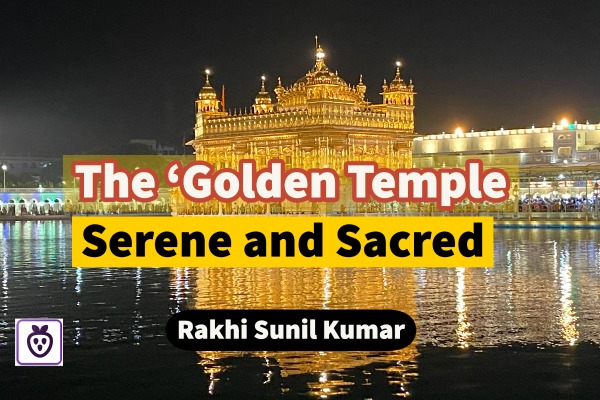
The ‘Golden Temple – Serene and Sacred

The ‘Golden Temple – Serene and Sacred
The Golden temple was on my bucket list for many years but for some reason, it did not happen, and as they say, “it will happen only when blessings come!” So this year, finally I could visit the holy shrine, and pay my tributes to the great Gurus of Sikhism.
The Golden Temple needs no introduction, the temple is known around the world for its openness to people from all faiths, its golden dome and great architecture, and sublime peacefulness. One of the most spiritual places in India, located in the heart of the Amritsar city, is the holiest shrine in all of Sikhism. Guru Nanak Dev, the founder of the Sikh religion spent time at this place. After the passing away of Guru Nanak, his disciples continued to frequent the site, and over the centuries it became the primary sacred shrine of the Sikhs.
The temple has a square plan with four entrances and a circumambulation path around a water body named ‘Amrit Sarovar’. At night the temple premise is lit with twinkling lights; one can take a walk around the Amrit Sarovar, have the Langar prasad, and listen to the divine songs, in complete calmness.
But the serenity of the temple beholds many stories in its history which are of destructions and invasions.
Initially built in 1588, the shrine was destroyed many times by the rulers of the Mughal Empire and the Afghan invaders. Each time it was rebuilt by the Sikhs. In 1830, Maharaja Ranjit Singh renovated the gurudwara and decorated it with a gold foil, which led it to be known as the ‘Golden Temple.
Mughal rulers and Afghan Sultans viewed the temple as the centre of the Sikh faith and it remained the main target of persecution. Key historical events of the Golden Temple during this period were:
(reference – https://en.wikipedia.org/wiki/Golden_Temple)
The growing influence and success of Guru Arjan led to his arrest and he was asked to convert to Islam. He refused. He was tortured and executed in 1606. Guru Arjan’s son and successor Guru Hargobind then left Amritsar and moved into the Shivalik Hills to avoid persecution. For about a century after Guru Arjan’s martyrdom, the Golden Temple was not occupied by the actual Sikh Gurus and it remained in hostile sectarian hands. In the 18th century, Guru Gobind Singh and his newly founded Khalsa Sikhs came back and fought to liberate it.
In 1709, the governor of Lahore sent in his army to suppress and prevent the Sikhs from gathering for their festivals of Vaisakhi and Diwali. But the Sikhs defied by gathering in the Golden Temple. In 1716, Banda Singh and numerous Sikhs were arrested and executed.
In 1737, the Mughal governor ordered the capture of the custodian of the Golden Temple named Mani Singh and executed him. He appointed Masse Khan as the police commissioner who then occupied the Temple and converted it into his entertainment centre with dancing girls. Sikhs avenged the sacrilege of the Golden Temple by assassinating Masse Khan inside the Temple in August 1740.
In 1746, another Lahore official Diwan Lakhpat Raiworking for Yahiya Khan, and seeking revenge for the death of his brother, filled the pool with sand. In 1749, Sikhs restored the pool when Muin-ul-Mulk slackened.
In 1757, the Afghan ruler Ahmad Shah Durrani, also known as Ahmad Shah Abdali, attacked Amritsar and desecrated the Golden Temple. He had waste poured into the pool along with entrails of slaughtered cows, before departing for Afghanistan. The Sikhs restored it again.
In 1762, Ahmad Shah Durrani returned and had the Golden Temple blown up with gunpowder. Sikhs returned and celebrated Diwali on its premises.
In 1764, Baba Jassa Singh Ahluwalia collected donations to rebuild the Golden Temple. A new main gateway (Darshan Deorhi), causeway and sanctum were completed in 1776, while the floor around the pool was completed in 1784. The Sikhs also completed a canal to bring in fresh water from the Ravi River for the pool.
Destruction of the ‘Places of Worship’ is a common thread we see in the invasions which happened in all parts of the world. Forceful Imposition, Destruction or Invasion of the culture, really destroys the spirit of the people or makes them more stronger to rebuild?
The Golden temple withstood all the invasions and damages but every time the devotees rebuilt it with more determination, resilience and strength, which is a lesson to all the invaders of the world who believe to paint the world the way they want it, destroying the local culture, traditions and beliefs.
Rakhi Sunil Kumar






Comments (0)
Please login to share your comments.